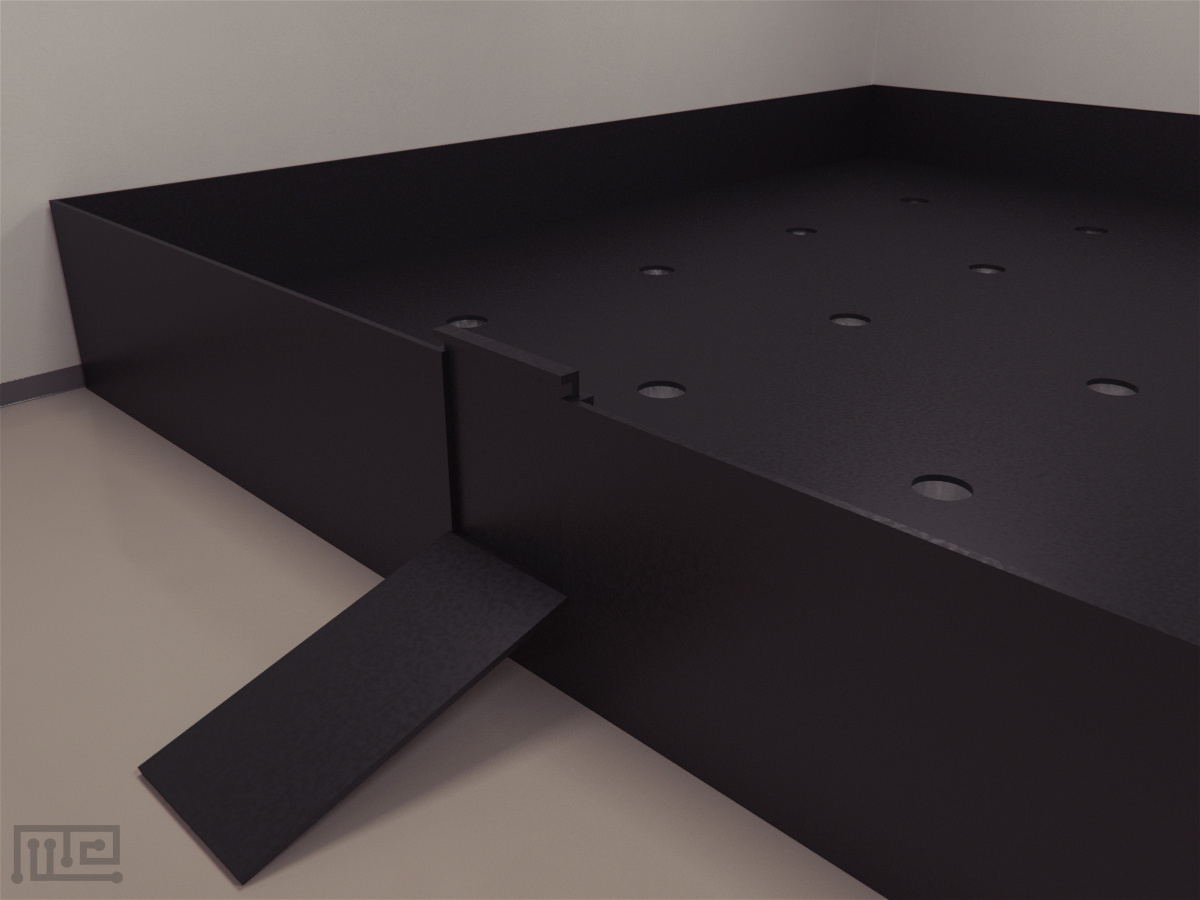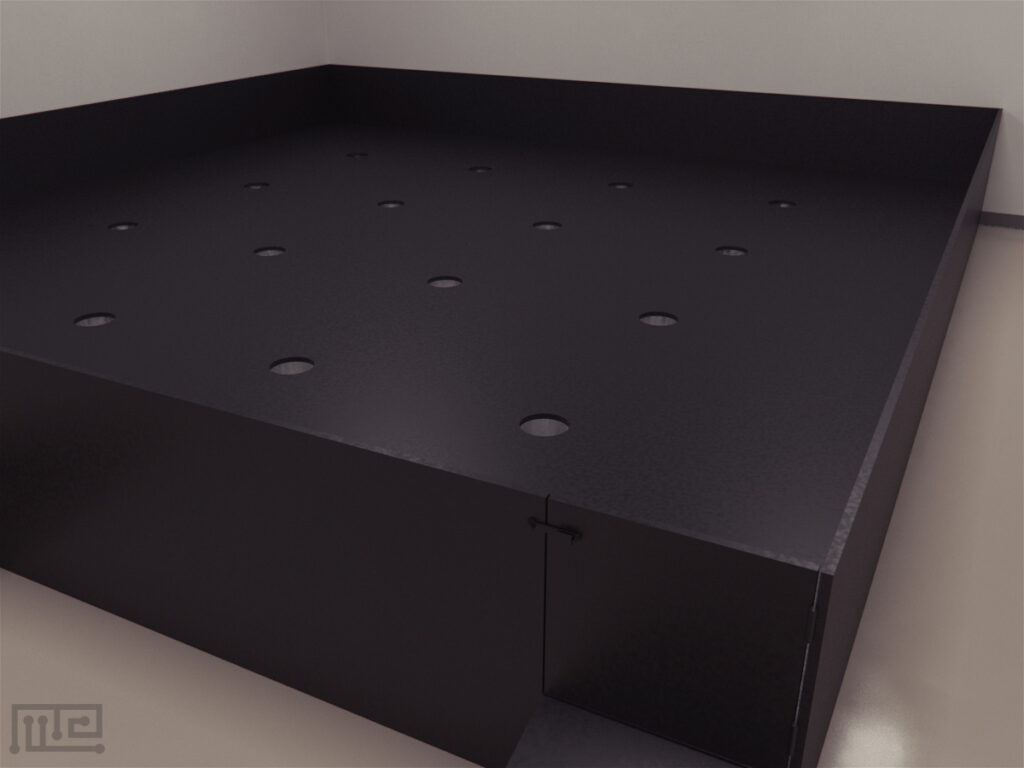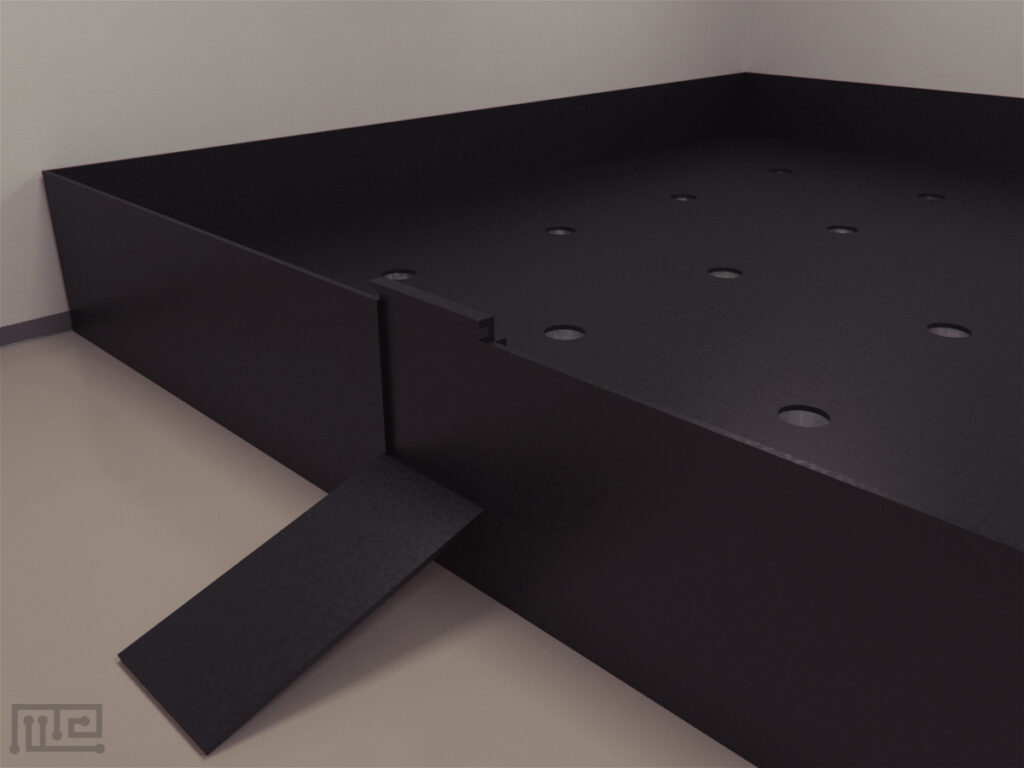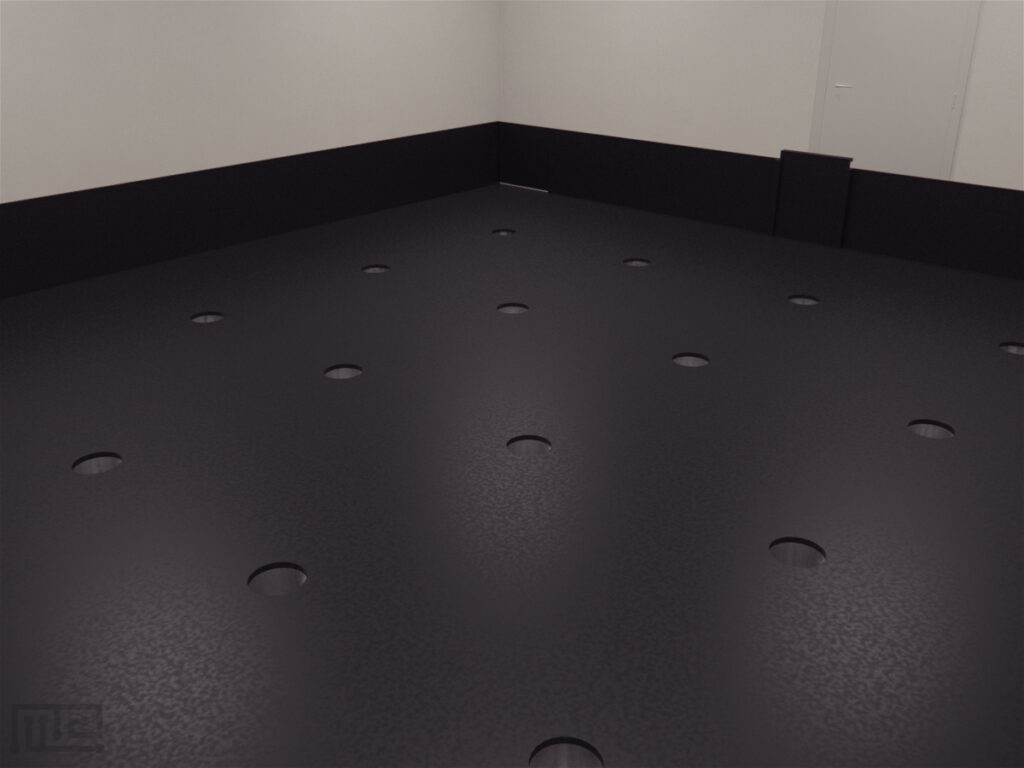The Pig Hole Board is used to study spatial learning and memory in pigs. It uses the same principle as the rodent Hole Board to study spatial learning and memory in pigs.
It consists of a testing arena that has 16 equally distanced buckets screwed on to the concrete floor. Each bucket has a perforated grid bottom to prevent the use of odor cues for locating food.
Observing the order of visits and repeated visits to an already visited bucket allow evaluation of working memory and reference memory of pigs.
Mazeengineers offer the Pig Hole Board.
Price & Dimensions
Pig Hole Board
$ 2490
+S&H- 8.0 m × 7.6 m testing area
- guillotine door to pen room
- 16 screw in reward chambers
Documentation
Introduction
The Pig Hole Board uses the same principle as the rodent Hole Board to study spatial learning and memory in pigs. The Pig Hole Board consists of a testing arena that has buckets, which can be baited with food, screwed to the concrete floor. The buckets contain a perforated grid under which a food reward can be deposited which masks odor cues emanating from the reward. Thus, preventing discrimination between baited and un-baited buckets by reliance on olfactory cues. The arena has a guillotine door in the middle of one of the sidewalls, that serves as the entrance to the testing arena.
The Pig Hole Board provides an environment to test the cognitive flexibilities in pigs in response to different spatial configurations of the baited and un-baited buckets. Observing the order of visits and repeated visits to an already visited bucket allow evaluation of working memory and reference memory of pigs. The Pig Hole Board can also be easily adapted for different experimental protocols, such as by inclusion of multiple entry points to evaluate the effect of different start points on performances. The Pig Hole Board can also be used to test the effects of diseases and disorders, brain lesions, and pharmacological manipulations on learning and memory. Further, improved understanding of the cognitive abilities of pigs can be used to improve animal welfare.
Other apparatus used in the evaluation of pig behaviors include the Pig T-maze, the Piglet T-maze, the Pig 8 Arm Radial Maze, the Pig Open Field, and the Pig Hebb-Williams Maze.
Apparatus and Equipment
The Pig Hole Board consists of a testing arena that measures 8.0m x 7.6m and connects to the pen room through a passage. A guillotine door is present in the middle of one of the sidewalls that serve as the entrance along with an exit door in the corner of the same side wall. Sixteen buckets which are equally distanced from each other are tightly screwed to the concrete floor of the testing arena. Each bucket has a perforated grid bottom under which a food reward can be deposited. The concrete floor is covered with black mats to equalize the unevenness of the floor and provides good contrast for the video camera.
Training protocol
Clean the apparatus after every trial. Clean the buckets with a wet towel between trials. Replace the food reward on the bottom of the buckets after every trial. Appropriately light the maze arena. A tracking and recording system such as the Noldus Ethovision XT can be used to assist with observations.
Habituation and Pre-training
After a week of handling, allow the subjects to explore the passage between the pens. After two weeks of handling allow the subjects to explore the Pig Hole Board. After three weeks of handling guide the subjects individually to the Pig Hole Board and back to their pens. Ring a doorbell to allow the subjects to familiarize the sound of the doorbell with returning to their pens. Place a food reward in 8 of the 16 buckets of the apparatus. Allow the subjects to find and eat the rewards. Conduct the trial for 1 min and extend this period by 1 min on each succeeding day. Place the food reward in all 16 buckets for the last 3 trials. Ring the doorbell and return the subject to its pen after it finds all the 16 rewards or maximum session duration is reached. Conduct pretraining trials for 7 consecutive days.
Pig Hole Board acquisition task
Bait 4 buckets with the food reward in a predetermined configuration. Slide the entry door upwards and let the subject enter the Pig Hole Board. Allow the subject to explore the maze and find the food rewards. Conduct the trial until the subject finds all the 4 rewards or until 10 minutes have elapsed. Provide an audio cue once the trial stops. Return the subject to its home pen. Change the configurations of the baited and un-baited buckets for every trial (if required). Conduct a total of 28 trials or as required.
Pig Hole Board reversal task
Following the acquisition trials, conduct 16 reversal trials for 8 days. Reverse the configurations of the baited buckets from the acquisition trials. Perform the task using the same protocol as the acquisition trials.
Evaluation of working and reference memory in pigs
Arts et al. (2009) evaluated working and reference memory in pigs using the Pig Hole Board. It was also used to test whether stress affected performance in the task. Ten pairs of female, full siblings (Finish Landrace×York F1) were used. The study involved three phases which consisted of different configurations of baited holes; phase A (Baited buckets 2, 7, 9, and 16), phase B (Baited buckets 1,8, 10, and 15) and phase C (Baited buckets 3, 6, 12, and 13). Pigs were subjected to mixing stress by being housed with unfamiliar pigs during phase C. For phases A and B it was observed that working and reference memory improved during training. Trial duration also decreased over trials. For phase C, it was observed that mixing stress before the trials did not affect task performance as the working memory and reference memory performance did not differ between the stress and non-stressed groups. Trial duration decreased at a similar pace in the stressed and non-stressed pigs during trials. Overall, all pigs rapidly reduced the number of re-visits to baited holes (working memory) and to un-baited holes (reference memory).
Evaluation of the influence of environment enrichment on the working and reference memory in pigs
Bolhuis et al. (2013) evaluated the influence of different housing conditions (barren vs. enriched) during rearing on the cognitive performance of pigs. Thirty-two pigs (Sus scrofa domesticus) were subjected to 30 trials on a Pig Hole Board. It was observed that pigs from a barren environment had a higher number of working memory errors and a lower working memory score as compared to pigs from an enriched environment. The reference memory scores increased with time and errors decreased across trials and were not affected by housing conditions. Apart from the working memory and reference memory of pigs, the general working memory was also calculated as the ratio between the number of buckets visited and the total number of visits. The general working memory improved over trial blocks and was higher for enriched pigs than barren housed pigs. Personality type did not affect performance in the task. Overall, housing conditions did not affect reference memory performance, but environmental enrichment improved working memory performance.
Evaluation of the effects of late prenatal and/or early postnatal exposure to a Western-type diet on the cognition of pigs
Clouard et al. (2016) examined the effects of 8 weeks prenatal and/or 8 weeks postnatal exposure to a western diet enriched in saturated fat, sucrose, and cholesterol on the cognitive performance of piglets in later life. Thirty-six multiparous sows (Topigs 20) and their litters (Tempo 3 x Topigs 20) were tested in the Pig Hole Board task that had 4 baited buckets. In the acquisition trials, it was observed that the piglets which were exposed to the prenatal western diet had higher working memory scores and made fewer errors than piglets exposed to the prenatal control diet. Reference memory scores were not significantly affected by the prenatal diet. Latency to the first bucket visit and the fourth bucket visit were not influenced by the prenatal diet. However, the inter-visit interval tended to be longer. Piglets exposed to the prenatal western diet made fewer visits in total and consumed fewer rewards during the first trial block than piglets exposed to the prenatal control diet. In the reversal trials, it was observed that piglets exposed to the prenatal western diet tended to have higher working memory and reference memory scores and made fewer errors as compared to the piglets exposed to the prenatal control diet. The prenatal western diet increased the inter-visit duration and reduced the total number of visits and resulted in longer latency to visit the first bucket. Latency to fourth reward and the number of rewards consumed were not influenced by the prenatal diet.
Data Analysis
The following can be observed on a Pig Hole Board:
- Number of times subject puts its nose above a bucket
- Number of times subject finds a food reward
- Number of times subject visits a baited bucket
- Number of times subject visits an un-baited bucket
- Number of times subject revisits a bucket
- Total number of buckets visited
- Time taken to complete a trial
Strengths and Limitations
Strengths
The Pig Hole Board is an open arena equipped with buckets that have a perforated grid base. The bucket design allows placement of food rewards under the grid which prevents the use of olfactory cues during the task. The maze allows assessment of spatial learning and memory in pigs using different configurations of the baited and un-baited buckets. The Pig Hole Board task can easily be modified by utilizing the inclusion of multiple entries which would increase the working memory load of the subjects by randomly placing them in different start positions. It is a non-aversive task that does not elicit stress or fear. The Pig Hole Board can also be used to test the effects of diseases and disorders, brain lesions, and pharmacological manipulations on learning and memory.
Limitations
Stress may interfere with task performance. The exploratory drive and motivation to find food for subjects is necessary to complete the task. Factors such as age, gender, and strain of the subjects may contribute towards their task behavior. Unnecessary stimuli may affect the way the subject performs the task. Proper cleaning of the Pig Hole Board is needed before starting each trial.
Summary
- The Pig Hole Board is used to study spatial learning and memory in pigs.
- The Pig Hole Board consists of a testing arena that has 16 equally distanced buckets screwed on to the concrete floor.
- Each bucket has a perforated grid bottom to prevent the use of odor cues for locating food.
- The Pig Hole Board can be used for the assessment of cognitive flexibilities in pigs in response to different spatial configurations of the baited and un-baited buckets.
References
- Arts, J. W., van der Staay, F. J., & Ekkel, E. D. (2009). Working and reference memory of pigs in the spatial holeboard discrimination task. Behavioural brain research, 205(1), 303-306. doi: 10.1016/j.bbr.2009.06.014
- Bolhuis, J. E., Oostindjer, M., Hoeks, C. W., de Haas, E. N., Bartels, A. C., Ooms, M., & Kemp, B. (2013). Working and reference memory of pigs (Sus scrofa domesticus) in a holeboard spatial discrimination task: the influence of environmental enrichment. Animal cognition, 16(5), 845-850.
- Clouard, C., Kemp, B., Val-Laillet, D., Gerrits, W. J., Bartels, A. C., & Bolhuis, J. E. (2016). Prenatal, but not early postnatal, exposure to a Western diet improves spatial memory of pigs later in life and is paired with changes in maternal prepartum blood lipid levels. The FASEB Journal, 30(7), 2466-2475.




